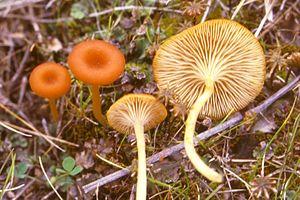Orange rings
| Orange rings | ||||||||||||
|---|---|---|---|---|---|---|---|---|---|---|---|---|

Orange-red Loreleia ( Loreleia postii ) |
||||||||||||
| Systematics | ||||||||||||
|
||||||||||||
| Scientific name | ||||||||||||
| Loreleia | ||||||||||||
| Redhead , Lutzoni , Moncalvo & Vilgalys |
The Orangenabelinge ( Loreleia ) are a genus of fungi from the order of the bristle disk-like with unclear family affiliation, whose species form umbilical-like fruiting bodies with happy orange and hygrophanic hats. Despite the similarity with the umbilical rings ( Omphalina s. Str. ), The Loreleien are not closely related to them. The neighborhood includes, for example, the equally joyful orange pigmented orange-red label ( Rickenella fibula ), but also mushrooms with completely different types of fruiting bodies, such as the blood-red bristle disc ( Hymenochaete cruenta ) or the purple cystid lump ( Alloclavaria purpurea ).
The type of Loreleia is the orange-red orange labeling ( Loreleia postii ).
features
Macroscopic features
The domed to expanded, depressed hat has a smooth surface and a rounded or straight edge. The diameter is 2 to 25 mm. Depending on the humidity, the hat color changes (hygrophan) and the lamellas on the underside appear more or less as grooves through the orange-colored hat skin. The rather thick than thin lamellae run down the stem, are medium to distant and are white to yellowish in color. The spore powder makes a white impression. The stem, 5 to 70 mm long and 0.5 to 2 mm thick, has a smooth and frosted stem bark at the tip and is orange in color. Both the smell and the taste are unspecific.
Microscopic features
The spores are smooth, thin-walled and transparent ( hyaline ). When iodine reagents are added, they show no color reaction, cannot be stained with cotton blue (acyanophil) and do not discolour reddish or violet (not metachromatic ) on contact with cresyl blue dissolved in water . The spore stands ( basidia ) each develop (2–) 4 spores. There are no cystids on the lamellae (cheilocystids and pleurocystids), as well as on guard (pileocystids). On the other hand, they are present on the stalk bark (caulozystiden). The hat cover layer (Pileipellis) is constructed as a cutis. The fungal threads ( hyphae ) have no buckles on the transverse walls ( septa ) in the entire fruiting body .
Ecology and phenology

Orange mosses either live saprobionically on mosses or are only viable together with liverworts . In the latter case, the fungus penetrates the rhizoids of the liverwort and is able to form a kind of symbiosis with it. However, the liverwort orange label ( Loreleia marachtiae ) in pure culture killed the inoculated well liverwort ( Marchantia polymorpha ); in contrast to natural occurrences without necrosis.
The fruiting bodies appear from spring to autumn.
species
For Europe 3 taxa are known or expected.
| Loreleien ( Loreleia ) in Europe |
Liverwort orange
label Loreleia marchantiaeOrange-red orange
label Loreleia postii
Origin of name
The scientific generic name "Loreleia" has no connection with the well-known slate rock on the Middle Rhine (see Loreley ), but is dedicated to the American mycologist Lorelei Lehwalder Norvell for her research work with umbilical-like agaric mushrooms .
swell
literature
- Frieder Gröger: Identification key for agaric mushrooms and boletus in Europe. Part I . In: Regensburger Mykologische Schriften . tape 13 . Regensburgische Botanische Gesellschaft , 2006, ISSN 0944-2820 (master key; generic key; species key for Röhrlinge and relatives, wax leafs, light-leaved mushrooms, light-leaved ones and red blooms).
- Erhard Ludwig: Descriptions . The smaller genera of macromycetes with a lamellar hymenophore from the orders Agaricales, Boletales and Polyporales. In: Mushroom Compendium . tape 1 . IHW, Eching 2001, ISBN 978-3-930167-43-2 (758 pages, German with English summaries, 17 × 24 cm, contains 20 new taxa and 13 new combinations).
Individual evidence
- ↑ Lorelei L. Norvell, Scott A. Redhead, Joseph F. Ammirati: Omphalina sensu lato in North America 1-2. 1: Omphalina wynniae and the genus Chrysomphalina. 2: Omphalina sensu Bigelow. In: Mycotaxon . tape 50 , 1994, pp. 379-407 ( scans online from Cyberliber ).
- ↑ Bryn T. M. Dentinger, David J. McLaughlin: Reconstructing the Clavariaceae using nuclear large subunit rDNA sequences and a new genus segregated from Clavaria . In: Mycologia . tape 98 (5) , 2006, pp. 746–762 , doi : 10.3852 / mycologia.98.5.746 ( PDF; 1.2 MB ).
- ↑ a b Scott A. Redhead, Jean-Marc Moncalvo, Rytas Vilgalys, François Lutzoni: Phylogeny of agarics: partial systematics solutions for bryophilous omphalinoid agarics outside of the Agaricales (euagarics) . In: Mycotaxon . tape 82 , 2002, pp. 151–168 ( PDF; 1.7 MB ).
- ↑ a b c d Henning Knudsen, Jan Vesterholt: Funga Nordica. Agaricoid, boletoid and cyphelloid genera . Nordsvamp, Copenhagen 2008, ISBN 978-87-983961-3-0 (English, revision of Nordic Macromycetes Volume 2; incl. CD “MycoKey 3.1”).
- ^ Andreas Bresinsky, Angelika Schötz: Behavior in cultures and habitat requirements of species within the genera Loreleia and Rickenella (Agaricales) . In: Acta Mycologica . tape 41 , no. 2 , 2006, p. 189–208 ( PDF; 172 kB ).
- ↑ Gerhard Kost: Moss inhabiting basidiomycetes. III. Interactions between basidiomycetes and bryophyta . In: Endocytobiosis and Cell Research . tape 5 , no. 3 , 1988, pp. 287–308 ( PDF; 17 MB ).
- ↑ Eric Strittmatter: The genus Omphalina . In: fungiworld.com. Mushroom Taxa Database. July 25, 2011, accessed on January 9, 2013 (including Update No. 100).

